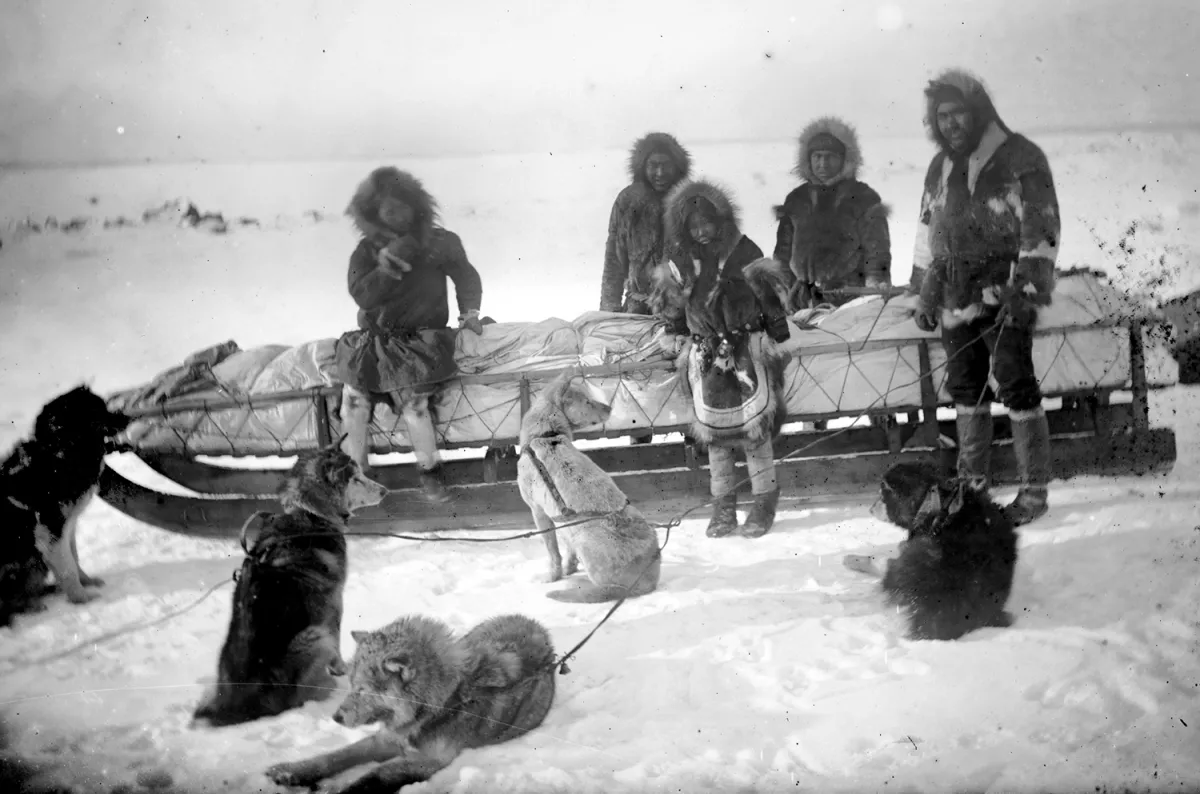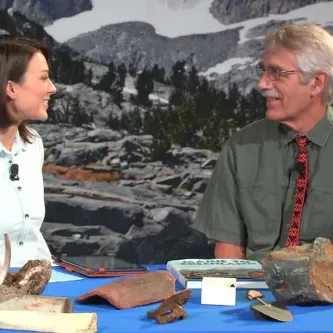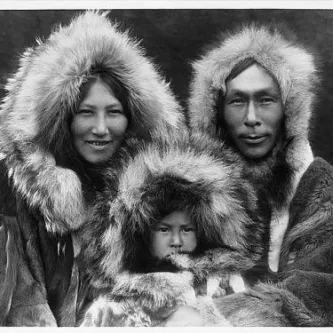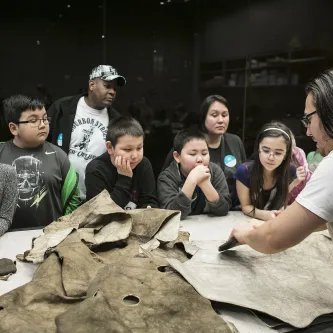
Search
Arctic Lands and Peoples
Early Arctic Inhabitants
The diverse landscapes of the Arctic tundra and ice-covered seashores have been home to peoples and cultures, not to mention some of the hardiest plants and animals, for thousands of years. The earliest human inhabitants of the Arctic were there some 40,000 years ago, even before humans arrived on the North American continent in Alaska.
More Than Just Ice
Technically speaking the Arctic is the area above 66 degrees and 30 minutes North latitude, and while areas near the North Pole are mostly ice and have up to six months without daylight or nightfall, there are cities north of the Arctic Circle in Alaska, Canada, Greenland, Finland, Norway and Russia. The Arctic landscape ranges from cold and dry deserts to brush and lush tundra plants on frozen soil to icecaps like Greenland’s. Many Arctic coastal areas offer extremely rich habitats bustling with seabirds, fish, marine mammals, and invertebrates.
In the more southern areas of the Arctic, the vast boreal forests full of fir, spruce, and birch trees span much of the northern hemisphere and play a critical role in carbon sinks, climate, and global cooling. But as you move north, the land becomes treeless. Cold temperatures as low as -60 degrees Celsius, very high wind speeds, and a dearth of rain result in a northern boundary for trees. This "tree line" marks the point where trees can no longer survive such challenging conditions.
Life in the Arctic
Despite the cold climate, the Arctic is full of life. Although there are comparatively fewer species than in tropical climes, Arctic ecosystems are characterized by extraordinary concentrations of animals, including birds, fish, and marine mammals. Smaller animals like wolverines, lynxes, hares, and lemmings forage in the tundra. Swarms of pelagic birds, like puffins and auks, gather in massive seaside rookeries, while interior lakes and boreal forests are the nursery for many of North America's songbirds and waterfowl. Grizzly bears, wolves, caribou, saiga antelope, and musk ox inhabit the Arctic tundra. Marine animals like walruses, polar bears, whales, and eight species of seals, narwhals and belugas are found in the cold ocean waters and have long been sustainably harvested for food and important resources by all Arctic peoples. The health of these species is becoming increasingly a concern in light of pollution and the serious threats of climate change in the Arctic.

Indigenous groups with distinct cultures live throughout the Arctic. The Iñupiaq, Yup’ik, St. Lawrence Island Yupik, Sugpiaq, and Unangax peoples live on lands that are now part of Alaska. The Inuit live in four regions of Canada: Inuvialuit, Nunavik, Nunatsiavut, and Nunavut. Sámi peoples live in the northern areas of what is now Finland, Sweden, Norway, and western Russia. The Nenet, Khanty, Evenk, and Chukchi peoples live on lands that are now part of Russia. The Indigenous peoples of the Arctic also live in cities and towns across the world.
The Arctic Studies Center, National Museum of Natural History
Staff at the Arctic Studies Center (ASC) work with Indigenous peoples of the Arctic on research about northern lands, environments, and cultures and to facilitate access to Smithsonian collections and resources. Learn more about their work:
ASC Director and archaeologist Dr. William Fitzhugh has conducted fieldwork on hunting and fishing sites in Quebec’s Lower North Shore where the remnants of homes and tools have shed light on the interactions and adaptations Indigenous Arctic peoples have made. His work in Labrador, Baffin Island, and Quebec over 40 years reveals a long, complex history of Indian and Inuit cultures adapted to climatically-sensitive forest and tundra zones of the Far Northeast as well as to each other and to European newcomers.
Ethnologist Dr. Igor Krupnik of the ASC helped document valuable traditional knowledge in Arctic communities. His research with Alaska Natives as part of the fourth International Polar Year (IPY) provided important documentation about how Indigenous Arctic peoples and communities have adapted and will adapt to climate change in future.
ASC anthropologist and archaeologist Dr. Stephen Loring works with communities across northern Canada on a variety of cultural and heritage initiatives. He conducted community archaeology projects with Labrador Innu and Inuit young people and helps facilitate access to the Smithsonian's anthropological and ethnographic collections. The collaborative nature of ASC museum anthropology is represented in the Inuvualuit Living History project that brought Inuvialuit scholars, elders, and youth, and museum professionals together to celebrate and document Smithsonian collections.
At the ASC in Anchorage, Alaska, Dr. Aron Crowell conducts research in cultural anthropology, archaeology, and oral history. His published works reflect the importance of collaborations with Indigenous communities of the north and with other museums and research institutions. Through contributions by Alaska Native Elders and scholars in collections research and curation, Aron was a co-curator and project director of the long-term Smithsonian exhibition, "Living Our Cultures, Sharing Our Heritage: The First Peoples of Alaska," that opened at the Anchorage Museum in 2010. Dawn Biddison, Living Our Cultures exhibition researcher and Museum Specialist, works in collaboration with Alaska Native Elders, Knowledge-Holders, artists, educators, learners, and cultural organization staff on Indigenous heritage projects that include outreach, museum collections access and research, artist residencies, community fieldwork and workshops, public programs, and shared documentation and educational resources.
This article was updated December 4, 2024.


